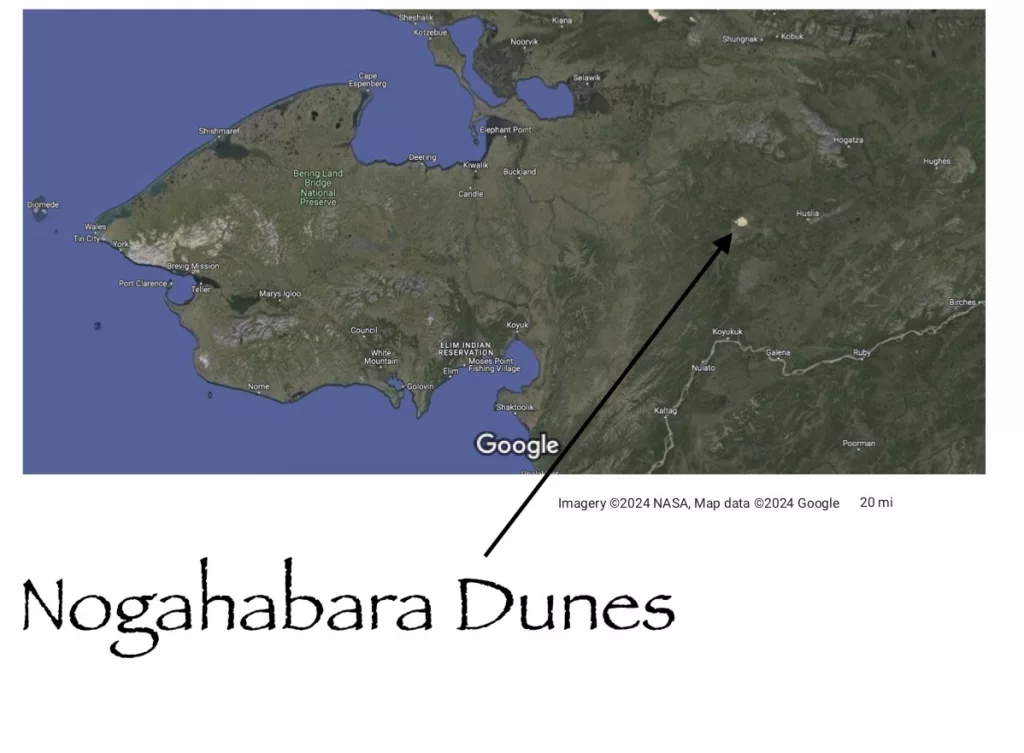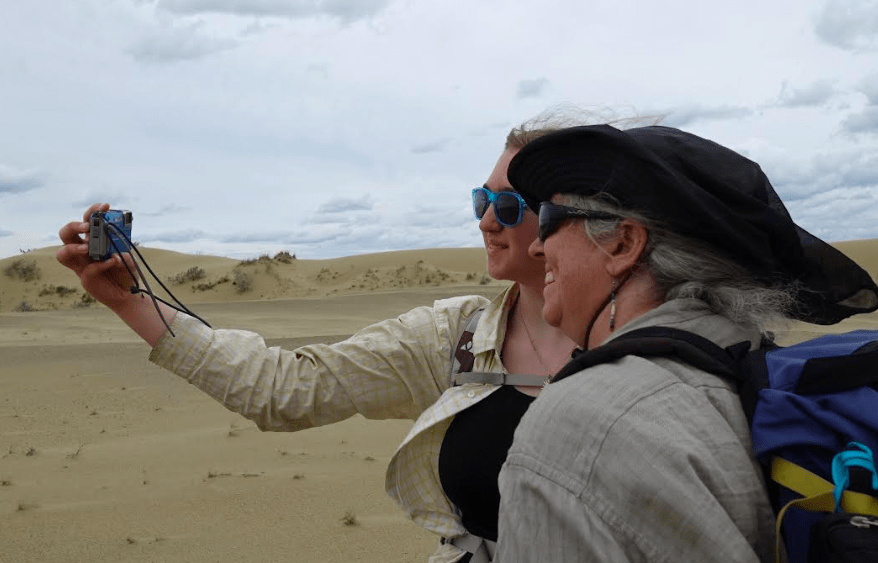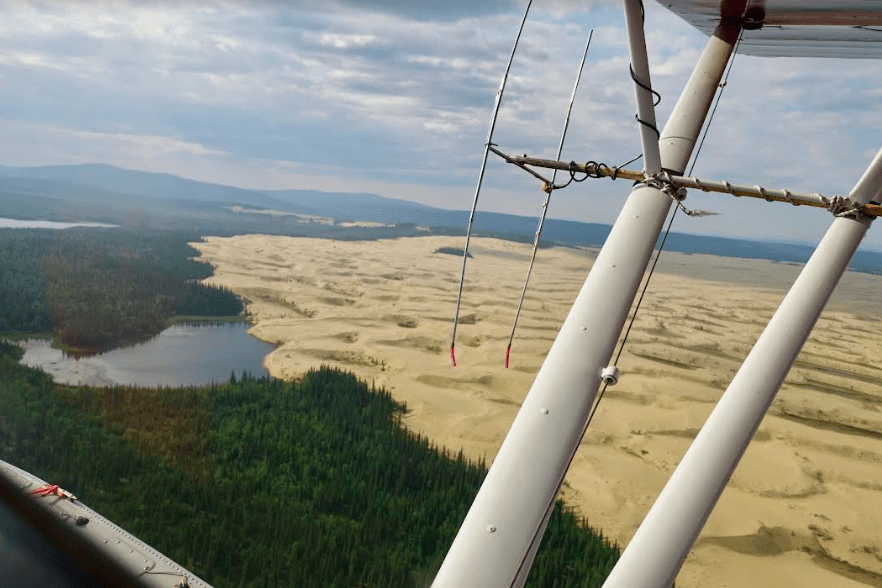
The Nogahabara Dunes spill into a lake 35 miles west of the village of Huslia as seen from the back seat of a Super Cub piloted by Brad Scotton of the U.S. Fish and Wildlife Service based in Galena. Photo by Ned Rozell.
Story by Ned Rozell
NOGAHABARA DUNES — From a molded seat of sand dug into the western rim of a 5-mile oval of desert, I’m looking out over a sea of tan waves. Spruce spears stick up here and there through the sand.
On this windy and cool day 35 difficult miles west of the closest village — Huslia on the Koyukuk River — I’m wearing all the clothes I packed, including rubber boots, a light jacket and raingear.
Back at our camp within the forested former sand dunes a few miles away, it’s buggy as heck. There, the silence is sometimes pierced with alarm calls of mother birds and the squeaks of their chicks. That songbird nursery is part of the Koyukuk National Wildlife Refuge, a place larger than the Anchorage bowl that is pocked by more than 15,000 lakes. The refuge also features one large disc of sand easily visible from space.
On the hour-long flight from Galena to here in a Super Cub on floats, I did not see one cabin, cell tower, boat or any other sign of the Anthropocene.
“In other places, we’re trying to restore ecosystems to what they were,” refuge biologist and pilot Brad Scotton said over the intercom. “Here we’re just trying not to screw things up.”
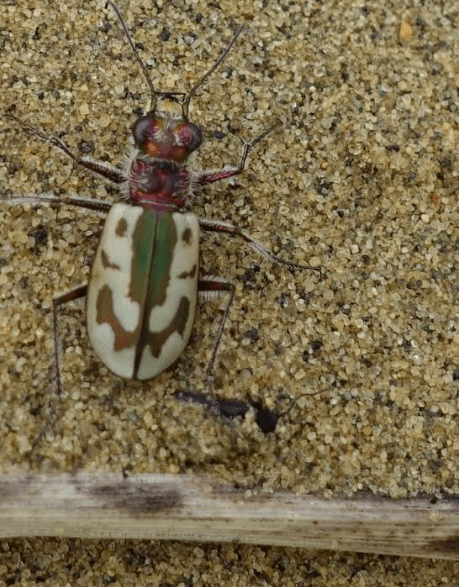
A tiger beetle roams the sands of Nogahabara Dunes 35 miles west of Huslia. Photo by Ned Rozell.
These spruce trees and rivers and swamps have not changed much since December 1980. That’s when Jimmy Carter signed the Alaska National Interest Lands Conservation Act. This wildlife sanctuary — and nearby Nowitna, Selawik, Kanuti and Innoko refuges — were part of 157 million acres of Alaska suddenly provided varying degrees of protection during Carter’s last few weeks in office.
The Nogahabara — a name from the Denaakk’e (Koyukon) language of the local Indigenous people — are dunes less known than the larger Kobuk dunes to the north. Few Alaskans seem to have heard about the Nogahabara, despite the fact that sand here spills out over almost the same acreage as it does in Great Sand Dunes National Monument in Colorado.
While walking these dunes, I am reminded of the Valley of 10,000 Smokes in Katmai National Park — still mostly unvegetated after the 1912 eruption and windy enough to pelt you with pumice. The dunes are also reminiscent of the far Aleutian Islands due to this week’s sudden cool temps, frequent rainfall and one’s inability to guess the time because there are no shadows.
But the Alaska similarities end there. These sand dunes — a mass of wind-blown granules ground up by glaciers thousands of years ago, migrating a few feet southward each year — are at the same time lonely and full of surprises.
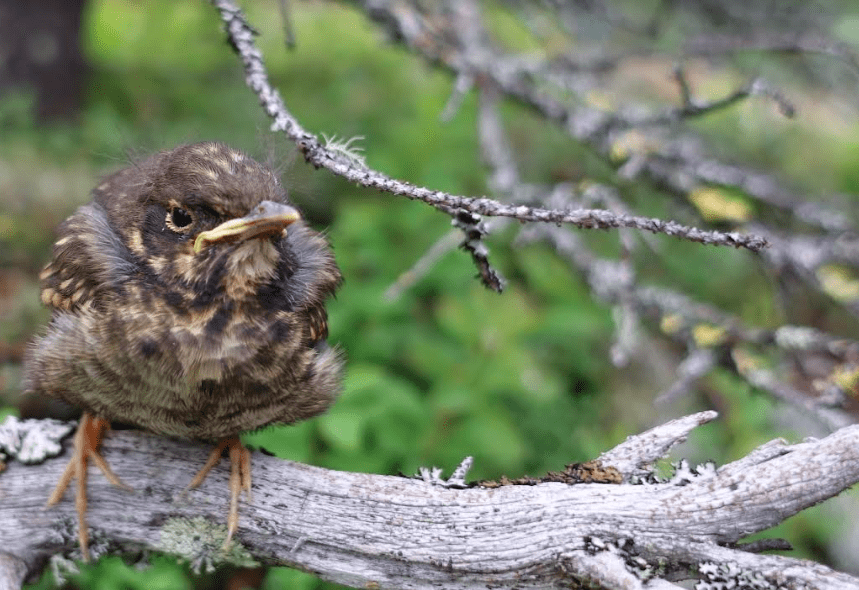
A Swainson’s thrush fledgling calls for its mother in the forested sand dune adjacent to the active Nogahabara Dunes 35 miles west of the village of Huslia. Photo by Ned Rozell.
Like the track of the lone wolf that loped in a straight line across the naked landscape this morning. Or the black bear that galloped away yesterday as the wind shoved my scent over a dune and to his nostrils. I watched his black dot get smaller for what seemed like a mile.
In this sand also lives the heat-loving sandy tiger beetle. Hiding beneath the surface today, this subspecies, a fierce predator the length of a fingernail, lives only in the Nogahabara Dunes. The dunes have been the beetles’ island of refuge since the last ice age, when glaciers pressed down on New York and Chicago and much of Alaska, but not here.
Also popping from the sand are the delicate leaves of the Baikal Sedge, found only here and the Yukon on this side of the International Date Line.
Then there are the sweet-smelling oases you stumble into after sand-skiing down the crest of a dune. They feature a carpet of lichen and moss upon which you’d like to pitch your tent, tiny ponds complete with dragonflies and wood frogs, a few spruce trees, and — always — a mother white-crowned sparrow clicking or lesser yellowlegs screeching an alarm call.
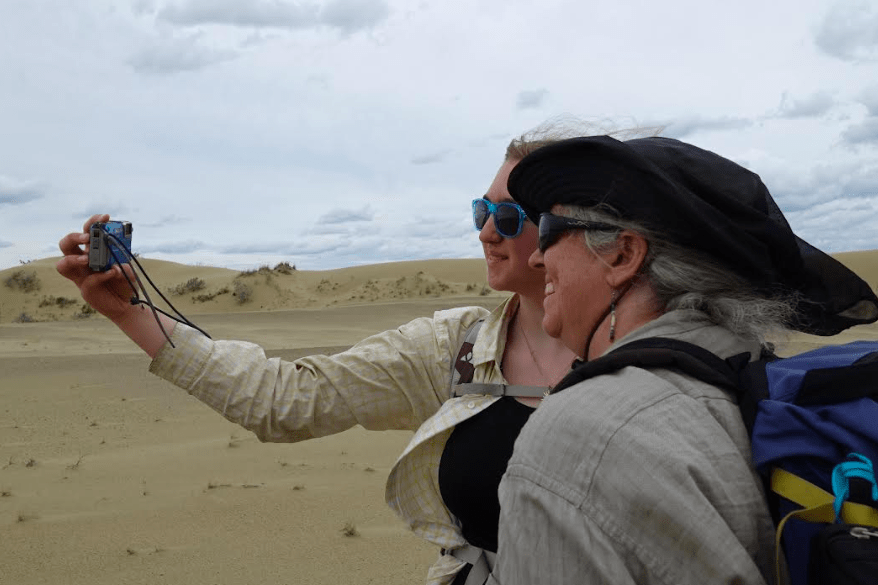
Fifteen-year-old Ida Bodony takes a selfie of herself and her mother Karin Bodony in the Nogahabara Dunes. They were there recently for a week to perform research recently in the heart of the Koyukuk National Wildlife Refuge. Photo by Ned Rozell.
Where there is a sliver of habitat here, there is life.
Even the human strain. Somewhere near here, refuge biologist Karin Bodony more than 20 years ago walked into a flat that featured dozens of black stones scattered on the sand. The sharp, palm-size rocks were obsidian pieces from a volcanic mountain 95 miles east of here. Why were so many precious weapon tips and cutting tools left in one place? The mystery endures.
Karin — now back at camp with her 15-year-old daughter Ida and refuge biologist Ryan Potter — invited me here to these sand hills that pour into the boreal forest. I am here to help her conduct science where I can, observe and record, and sleep on the ground in an intriguing place.
